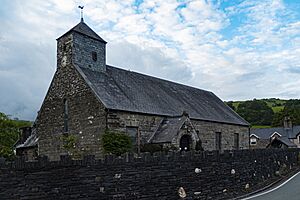St Peter ad Vincula, Pennal facts for kids
Quick facts for kids Church of St Peter ad Vincula |
|
|---|---|
 |
|
| 52°35′08″N 3°55′14″W / 52.58566°N 3.9205°W | |
| Location | Pennal, Gwynedd, Wales. |
| Country | United Kingdom |
| Denomination | Church in Wales |
| Website | www.hearthstone.co.uk www.churchinwales.org.uk |
| History | |
| Founded | 6th century |
| Dedication | Saint Peter in Chains |
| Architecture | |
| Years built | rebuilt 1700, 1761, 1810 and 1873 |
| Administration | |
| Parish | Pennal |
| Deanery | Cyfeiliog and Mawddwy |
| Archdeaconry | Meirionnydd |
| Diocese | Diocese of Bangor |
| Province | Wales |
The parish church of St Peter ad Vincula is located in the village of Pennal in Gwynedd, north-west Wales. Its name means Saint Peter in Chains. This church is very important because it was the place where the Welsh prince Owain Glyndŵr held his last big meeting.
The church was first started in the 6th century by two missionaries, Saints Tanwg and Eithrias, who came from Brittany. It is the only church in all of Wales with this special name. Today, it is part of the Bro Ystumanner group of churches in the Bangor area.
Contents
A Special Church in Wales
It is believed that Owain Glyndŵr chose this name for the church to compete with a chapel called St Peter ad Vincula in the Tower of London. That chapel was used by his rival, King Henry IV of England. Pennal was a respected place because it was one of the 21 llysoedd. These were important courts for the native Welsh Princes of Gwynedd.
The Pennal Letter
A famous document called the "Pennal Letter" of 1406 came from Pennal. This letter was sent by Owain Glyndŵr to King Charles VI of France. In it, Glyndŵr explained his plans for an independent Wales.
The original letter is kept in the Archives Nationales in Paris, France. However, copies of the letter are on display in Wales. You can see them at the Parliament House in Machynlleth and at the National Library of Wales. The original letter was brought back to Wales for a short time in 2000 for an exhibition. Since then, many people have wanted it to be returned permanently to Wales. They hope it could be shown at the Senedd in Cardiff.
A Garden for Princes
A special memorial garden was created in the churchyard to honor the native Welsh princes. This garden was made when Rev. Geraint ap Iorwerth was in charge of the church, from 1989 to 2012.
The garden features a bronze statue of Owain Glyndŵr. This statue was made by an artist named Dave Haynes from Bethesda. It was officially revealed in 2004. A famous musician, Robert Plant, who had given money to help pay for the statue, attended the opening event. Other well-known people who donated included Ray Gravell, Aneurin Jones, and Julia Ormond.
The Church Building
The Church of St Peter ad Vincula is a Grade II listed building. This means it is an important historical building. Much of the church you see today was built in the 18th century. The original medieval church was rebuilt in 1700. The entrance porch is made from stone that came from the nearby Llugwy Quarry.
Inside the church, you can see beautiful stained glass windows. Some of these were made by Holland & Holt in 1872. Others were created by Ernest Penwarden in 1923.
See also
- Buildings associated with Owain Glyndŵr

